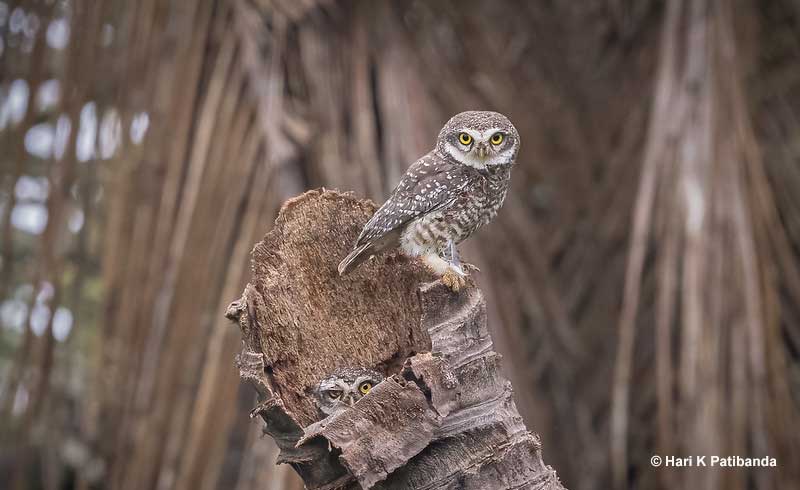The Spotted Owl (Strix occidentalis) is a medium-sized, round-headed, dark brown owl decorated with white spots.
This uncommon owl species can be seen in old growth forest and mature forest habitats from southwestern British Columbia to California. It also lives in montane forest habitats at scattered locations from Utah and Colorado to central Mexico.
If you hear abrupt hooting calls in forested canyons and evergreen forests in some parts of western North America, you may have found a Spotted Owl! However, if that calling owl is in the Pacific Northwest, take a closer look, it might be the closely related Barred Owl.
On this page
Identification
Male
The male Spotted Owl is a medium-sized owl with dark brown plumage. A little bit smaller than a crow, male Spotted Owls are around 16 inches long and have a three-foot wingspan. These nocturnal birds have a weight of around one pound.
Spotted Owls have a brown face with a narrow black outline, big dark eyes, and a pale greenish beak. They have small white spots on their backs and lots of bigger white spots on their underparts.
These owls have small pale spots and some dark barring on their big, broad wings. They also have dark barring on their fairly short, broad tail.
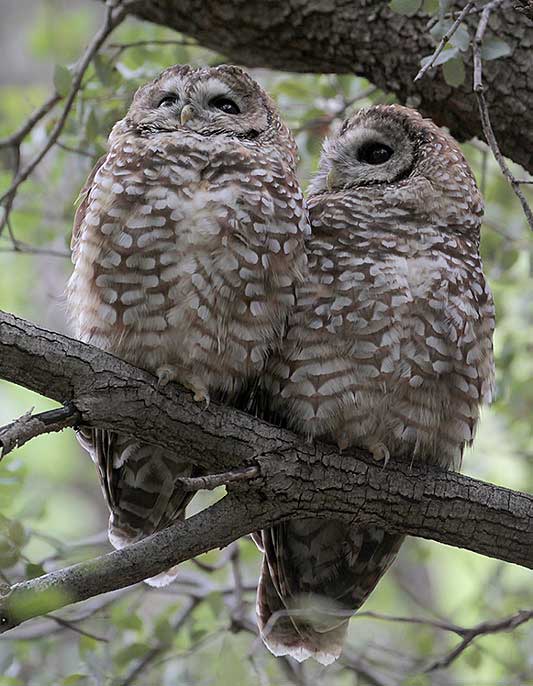
Female Spotted Owls are larger than their male counterparts.
Female
Compared to males, female Spotted Owls look just like their male counterparts but are noticeably bigger. They are a little bit larger than a crow and have a length of 17.5 to 19 inches. These fair-sized owls also have a wingspan of three and a half feet and can weigh one and a half pounds.
Like the male Spotted Owl, females are mostly dark brown with white spotting.
They have feathered legs with sharp black talons, and fly with deep flaps and glides on silent wings.
Both sexes of the Spotted Owl make various barking and rising whistle calls. Their “song” is a series of four or five “barking” sounds, “Whoot! Wook Wook Woo Wooah”.
Food
Spotted Owls mostly feed on rodents although they occasionally eat other small animals too. Northern populations are dependent on the Northern Flying Squirrel but also catch different species of voles, other rodents, and Snowshoe Hares.
In other parts of their range, this species eats more voles, rabbits, and bats. They can also eat insects and catch the occasional small bird and amphibian. Like many other owl species, when they can, Spotted Owls won’t hesitate to catch Western Screech-Owls or other owl species smaller than themselves.
Owl species probably do this to eliminate competition while also catching a meal.
The Spotted Owl usually starts foraging an hour after sunset and an hour before sunrise. On rare occasions, they also catch an animal during the day. They hunt by waiting on a perch for a squirrel or other small animal to reveal itself, and then quickly fly in to snatch it with their talons.
This species often catches prey on the branches and trunks of mature forest but can also take animals on the ground. It also occasionally catches bats and insects in the air.
Spotted Owls prefer to feed inside older areas of forest, especially spots with big trees. They rarely come into the open or feed at the edge of the forest.
Nesting and Eggs
Spotted Owls form pairs in February and March and lay eggs by March and April. Before the female lays eggs, both sexes roost near the nesting site for one or two months.
This species doesn’t actually build a nest. Instead, it uses tree cavities, old squirrel or raptor nests, or platforms made of debris. It can also use a crevice on a cliff, structures, or other suitable situations.
Spotted Owls prefer to nest in old forest with a tall canopy or in steep canyons. Once a nesting site in chosen, before laying eggs, the female usually scrapes out a shallow depression or puts some of her feathers onto the nesting platform.
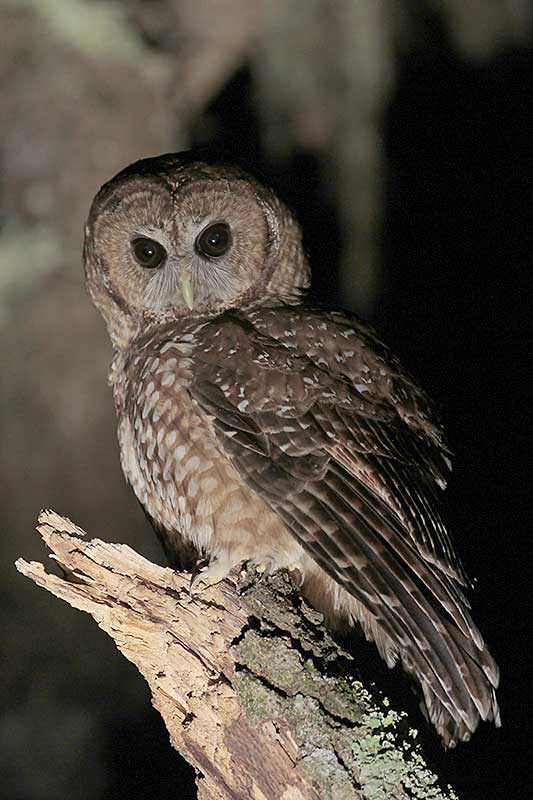
She lays one to four white or pale gray eggs that are 1.9 inches long and weigh .13 ounces. The female owl incubates her eggs for 30 days and during that time, is fed by her mate. He continues to feed her and bring food for young while the female broods her babies for the nest eight to ten days.
The young owls leave the nest around 30 days after hatching but stay nearby and continue to be fed by their parents for two to three more months.
Current Situation
Spotted Owls live in coastal old-growth, temperate rainforests in southeastern British Columbia to northern California. They also live in mature forests in other parts of California, and in canyons from Utah and Colorado to central Mexico.
The Spotted Owl is listed as Near Threatened in the IUCN Red List, Threatened in the USA, and Endangered in Canada. It is a species of special concern in California.
This owl has declined because it prefers mature forest and is very sensitive to logging. On a bright note, there is some evidence they can reoccupy areas 40 to 100 years after selective logging but only if snags and some big trees are present.
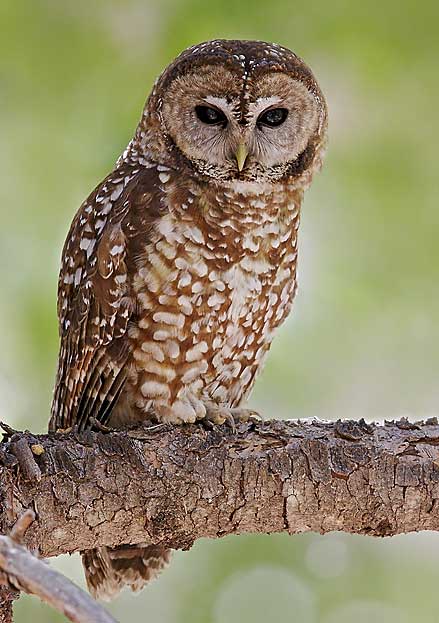
Photograph © Glenn Bartley.
In addition to being threatened by habitat degradation, in the north, Spotted Owls are being replaced by the Barred Owl. The bigger Barred Owls kill and eliminate Spotted Owls in logged areas.
Effective conservation measures for this species have been elusive. The challenge has always been figuring out how to protect enough mature forest for the owls without seriously affecting companies that want to log those same forests.
Facts
- Spotted Owls sometimes catch and store their prey under logs or other hiding places. They usually do this when they have an abundance of food. After storing their food, they may remember where they left it by staring at the spot for a few seconds before slowly backing away.
- Sadly this species is on the verge of extinction in Canada. In 2023, only one remaining bird was known to live in the country! In Canada, Spotted Owls only range in one small corner of southwestern British Columbia, a region where industrial logging plays an important role in the local economy. Reintroduction efforts are still being made to try and save this species in Canada.
- The Spotted Owl doesn’t fly in open areas nor above the canopy of its forest habitat. Instead, it is adapted to fly inside the forest and, if the owl needs to cool off or warm up, moves higher in the canopy or closer to the ground.
- Like many other owl species, the Spotted Owl usually swallows its prey whole.
Similar Species
The Spotted Owl is a fairly unique bird in most of its range. However, in some places, it can be confused with a few other similar owls.
Barred Owl
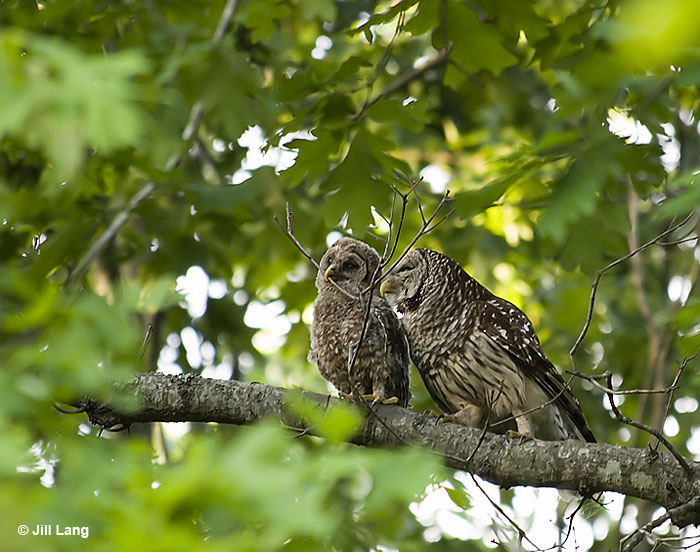
The most similar species to the Spotted Owl is the closely related Barred Owl. The Barred Owl can occur with or near the Spotted Owl in parts of the Pacific Northwest.
Although it has a round head and similar appearance, the Barred Owl has a gray rather than a brown face and dark streaks on its underparts instead of spots.
Great Gray Owl
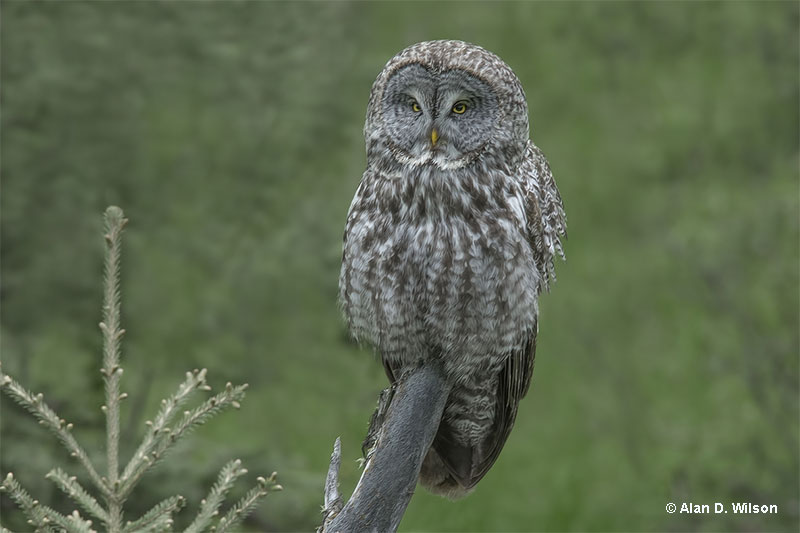
Great Gray Owls also hav a big, round head but are much larger than the Spotted Owl. It is darker gray, has yellow eyes, and lacks the white spotting shown by Spotted Owls.
The Great Gray Owl also lives in places where the Spotted Owl does not occur.
Short-eared Owl
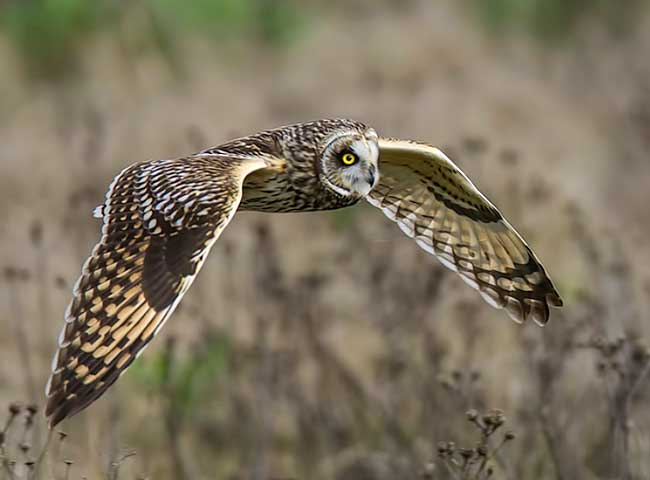
The Short-eared Owl has a small, round head with short ear tufts and flies over open habitats where the Spotted Owl does not occur.
It also has long wings with buff patches near its wingtips, and some dark streaking on its pale underparts.
Frequently Asked Questions
How rare is a Spotted Owl?
The Spotted Owl is a rare or uncommon bird in most of its range. In most areas, it lives at low densities and, in some parts of the Pacific Northwest and Canada, has been replaced by the Barred Owl.
Why are Spotted Owls endangered?
Spotted Owls are endangered because they require large areas of mature, old growth forest. It’s a challenge to protect this type of habitat because these forests provide valuable wood for logging companies.
What do Spotted Owls need to survive?
Spotted Owls need large areas of old growth forest to survive. They cannot live in edge or open habitats and need plenty of habitat for the small rodents they prey on.
Where does a Spotted Owl live?
A Spotted Owl lives in mature or old growth forest with lots of big trees and snags. They occur in the Pacific Northwest, California, and in canyons from Utah and Colorado to Mexico.
How long do Spotted Owls live?
Spotted Owls live for 12 years and sometimes for as long as 25 years. Although many young birds die, if a bird can reach adulthood, it can live for more than 12 years.

